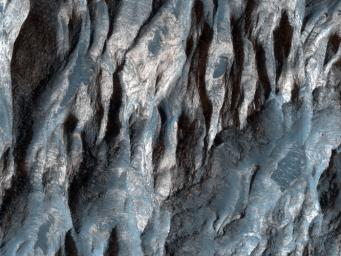
|
Strengths of Materials in Ganges Mensa
- Click the image above for a larger view
- Full-Res JPEG (2560 x 1920) (1.1 MB)
- Full-Res TIFF (2560 x 1920) (14.8 MB)
Caption:
The amount of time that a geologic deposit is exposed at the surface can be measured by counting the number of impact craters that is contains in a given area. The longer a deposit is exposed at the surface the more impact events that it endures.
In this image, there are at least two distinct geologic units, a light-toned bedrock and a surface veneer of dark-toned material that contains sand dunes. The light-toned bedrock must be older that the dark-toned veneer of sand; the bedrock must have been present first in order to be covered by the sand. The dark-toned sand however, contains many more impact craters than the light-toned bedrock. This suggests that the surface of the bedrock is younger than the veneer of sand.
This can be explained by the bedrock being more easily eroded by the wind than the veneer of sand. The surface of the bedrock is rapidly refreshed (craters smoothed away), while the sand veneer retains impact craters for a longer period of time. This indicates that the bedrock is very friable (weak and easily eroded, in this case by the wind) and the sand veneer is less friable.
Originally released June 6, 2007
Background Info:
NASA's Jet Propulsion Laboratory, a division of the California Institute of Technology in Pasadena, manages the Mars Reconnaissance Orbiter for NASA's Science Mission Directorate, Washington. Lockheed Martin Space Systems, Denver, built the spacecraft. The High Resolution Imaging Science Experiment is operated by the University of Arizona, Tucson, and the instrument was built by Ball Aerospace & Technologies Corp., Boulder, Colo.
Cataloging Keywords:
| Name | Value | Additional Values |
|---|---|---|
| Target | Mars | |
| System | ||
| Target Type | Planet | |
| Mission | Mars Reconnaissance Orbiter (MRO) | |
| Instrument Host | Mars Reconnaissance Orbiter | |
| Host Type | Orbiter | |
| Instrument | High Resolution Imaging Science Experiment (HiRISE) | |
| Detector | ||
| Extra Keywords | Color, Crater, Dune, Impact | |
| Acquisition Date | ||
| Release Date | 2010-10-23 | |
| Date in Caption | 2007-06-06 | |
| Image Credit | NASA/JPL-Caltech/University of Arizona | |
| Source | photojournal.jpl.nasa.gov/catalog/PIA13537 | |
| Identifier | PIA13537 | |
